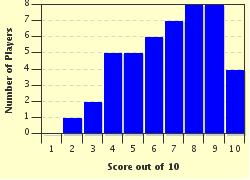Quiz Answer Key and Fun Facts
1. Which of the four fundamental forces binds quarks together to form atomic nuclei?
2. The ultraviolet catastrophe was a term given to the failure of classical physics to predict the emission spectrum of a blackbody.
3. Why is Bohr's planetary model of the atom inaccurate?
4. What is the name given to the constant that relates the energy of a photon to its frequency?
5. Angular momentum is a scalar quantity.
6. Which universal constant can be calculated by multiplying a photon's frequency by its wavelength?
7. Which of the following types of waves requires a medium to travel through?
8. According to Einstein's theory of general relativity, gravity can be defined as a distortion in space-time.
9. Which of the following particles is classified as a force-carrying particle?
10. Which of the following scientists was never directly involved in the field of quantum mechanics?
Source: Author
happy1234512
This quiz was reviewed by FunTrivia editor
WesleyCrusher before going online.
Any errors found in FunTrivia content are routinely corrected through our feedback system.

